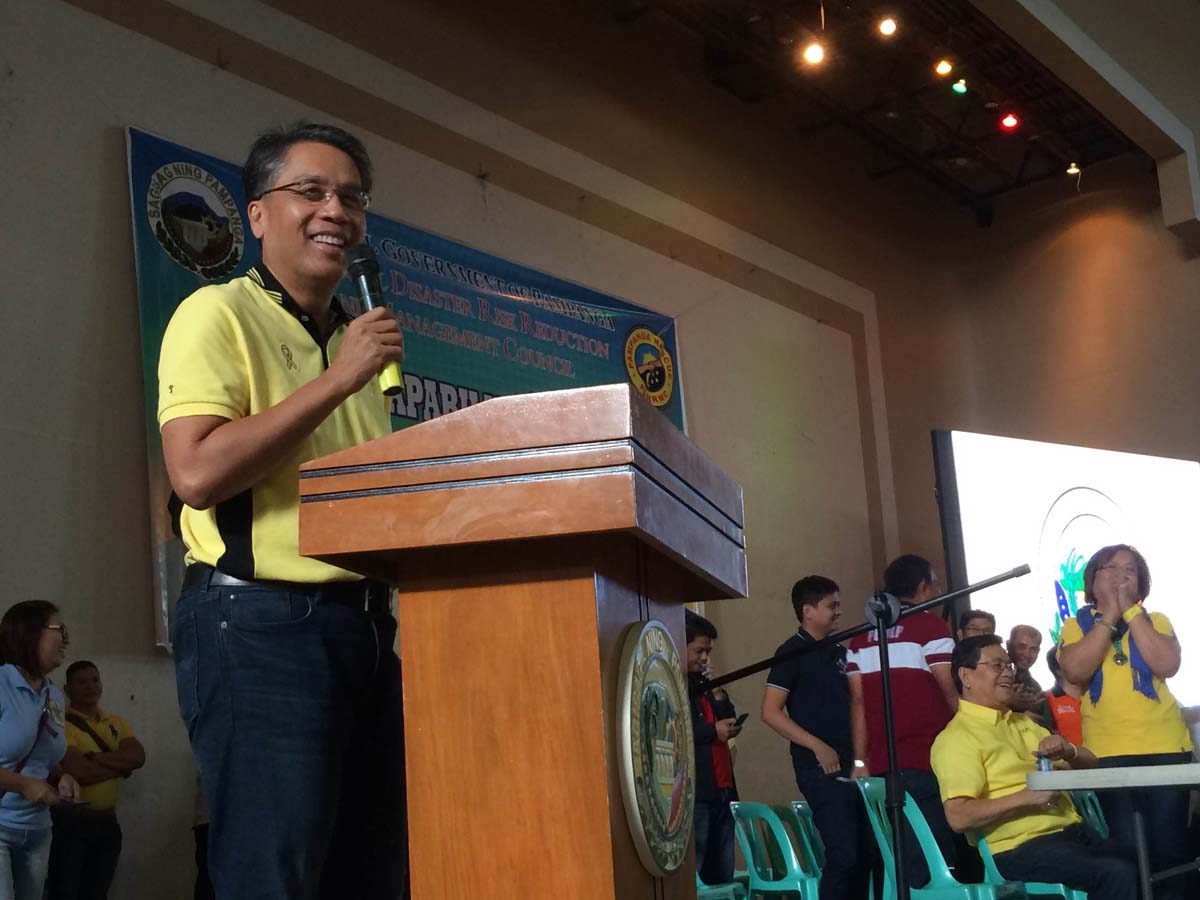SUMMARY
This is AI generated summarization, which may have errors. For context, always refer to the full article.

PAMPANGA, Philippines – For the “Daang Matuwid (Straight Path)” and Liberal Party (LP) standard-bearer Manuel Roxas II, the Clark International Airport in Pampanga should be the country’s main aviation gateway, though he did not give a timeline of when this should happen.
Speaking before a crowd of barangay (village) officials in San Fernando on Friday, December 18, Roxas said it was about time the country makes the most of the former US airbase, to ease congestion in the Ninoy Aquino International Airport (NAIA) in Metro Manila.
Plans to turn the Clark airport into the Philippines’ main gateway were revived during Roxas’ stint as transportation chief, but lack of supporting infrastructure – a rail system to bring passengers from the airport to Metro Manila – got in the way.
“Ang airport po doon sa Manila, nagrereklamo po sila. Masikip na masikip. Para sa Daang Matuwid, para kay Mar Roxas, ang airport ay ilipat dito sa Clark para dito na ang magiging ating international airport,” said Roxas, who was applauded by the crowd gathered for a disaster risk reduction workshop.
(They’re already complaining about the airport in Manila. It is very congested. For the Daang Matuwid and for Mar Roxas, the airport should be moved to Clark so that this becomes our main international airport),”
“Daang Matuwid” is the current administration’s catchphrase for its “philosophy of governance” which boasts of transparency, anti-corruption, and good governance drives.
Roxas said he was not simply saying this for political gain – NAIA is simply too small at roughly 400 hectares, compared to the Clark airport which is around 2,000 hectares.
In 2012, when Roxas was transportation chief, Aquino tasked him to study the possible expansion of NAIA. The study showed that it would be cheaper to build infrastructure to support the Clark airport than expand NAIA via reclamation.
“Kaya kung ang pag-uusapan ay development ng bansa, kung pag-uusapan yung transpormasyon ng ating bansa – sa Clark dapat ilipat ang ating airport sa lalong madaling panahon (So if you’re talking about developing the country, if you’re talking about transforming the country – we need to move the airport to Clark as soon as possible),” Roxas added.
It will take time
But the administration bet for the 2016 presidential elections was quick to point out that this could not happen immediately.
Before Clark becomes the country’s main hub, there must be a “fast train” to bring travelers quickly to Metro Manila. This way, they would not be forced to crowd the North Luzon Expressway, which connects provinces north of Metro Manila to the Philippine megacity.

“Bago mangyayari yan, gagawa tayo ng airport, gagawa tayo ng tren, papalaparin natin ‘yung highway para planado. Hindi yung bara-bara. Hindi ‘yung patsamba, tapos ‘pag nagawa na natin ay ang daming mali pala,” he added.
(Before that happens, we’ll build an airport, build a train, expand the highway, so it’s well planned. We won’t just throw caution into the wind. We won’t take chances and end up making too many mistakes later on),” he added.
In an interview with reporters after the event, however, Roxas could not pinpoint why between 2012 and 2015, plans to better connect the Clark airport to Metro Manila did not prosper.
In 2012, Roxas noted that the North Rail project was the “necessary ingredient” in making the Clark airport work. Local politicians, among them, Pampanga Governor Lilia Pineda, were among those consulted during the study.
Pineda was also present during Roxas’ Friday visit.
The controversial North Rail project was contracted out by the Arroyo administration in 2003 to the state-owned China National Machinery and Equipment Corporation (CNMEC) for an original cost of $421 million. In 2009, CNMEC increased the contract price to $593 million, with the government agreeing to shoulder the difference.
In 2011, the Aquino administration scrapped the project due to lingering legal issues and corruption allegations hounding the alleged overpriced project.
The following year, the Philippines renegotiated the Northrail loan with the state-owned China Export-Import bank which funded the project. The Philippine government had to pay China Exim a little over $180 million in 4 tranches, every 6 months starting September 2012, to protect the country’s credit rating standing.
By late 2012, the transportation department, still headed by Roxas, mulled the creation of a high-speed rail over the NLEX as an alternative to the North Rail project.
Roxas likewise confirmed on Friday that aside from the pace of negotiations with China, the proposed Northrail project was literally going to be too slow to ferry passengers between Clark and Metro Manila.
The relationship between the two countries have changed dramatically since the Arroyo administration. The Philippines, led by Aquino, is in a tense dispute with China over the West Philippine Sea (South China Sea).
Although Pampanga is considered “Arroyo country,” Aquino and Roxas won big in the province when the tandem ran in 2010. The LP standard-bearer, then Senator Benigno Aquino III, garnered over 47% of votes here, compared to his rival, then Makati Mayor Jejomar Binay’s 25%. – Rappler.com
Add a comment
How does this make you feel?
There are no comments yet. Add your comment to start the conversation.